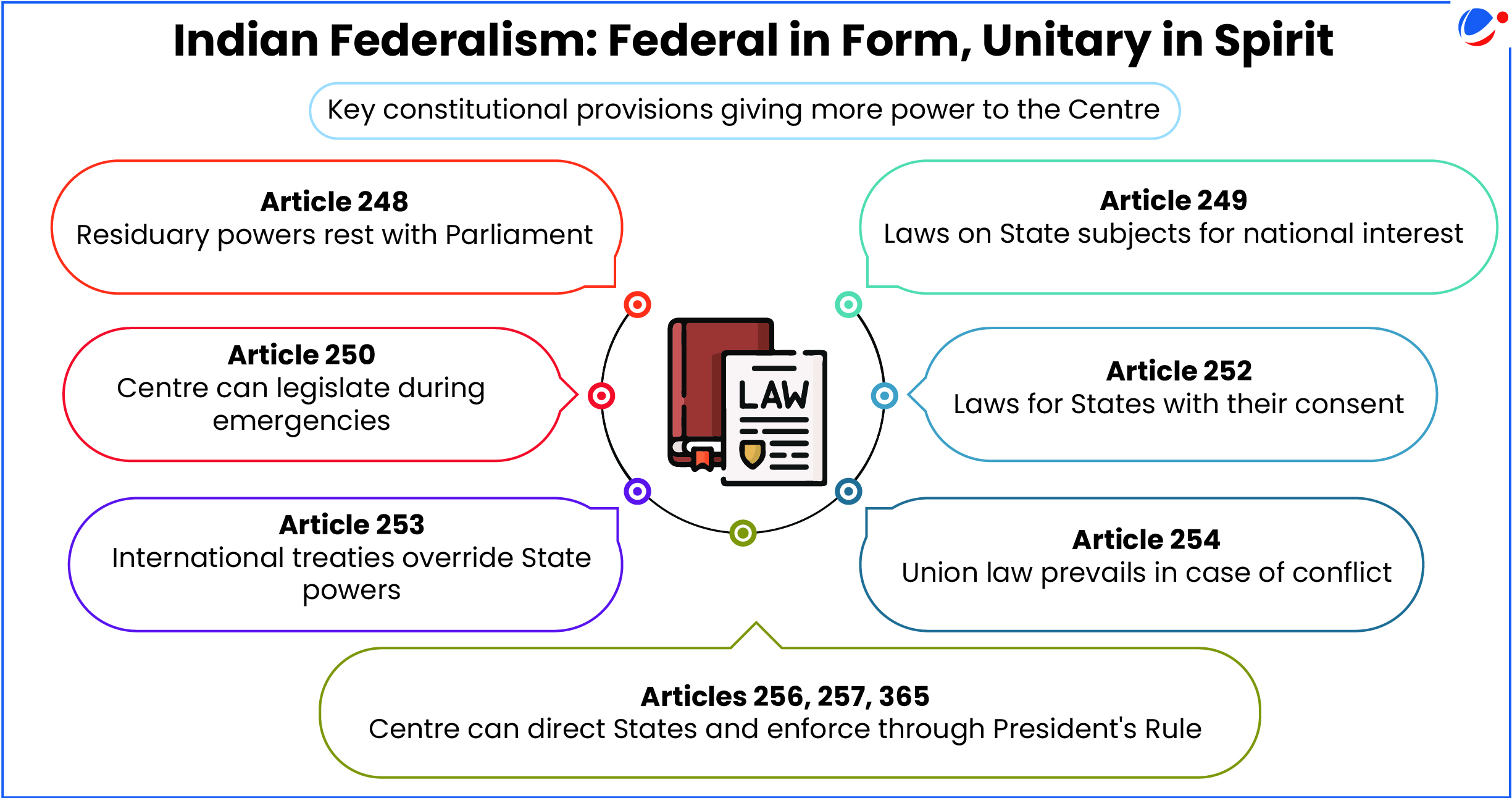Why in the News?
The Tamil Nadu government has formed a high-level committee to suggest ways to strengthen State autonomy and federalism.
More in the news
- The committee will be headed by former Supreme Court judge Justice Kurian Joseph.
- Mandate of the Committee:
- Review constitutional, legal, and policy aspects of Centre-State relations
- Suggest ways to restore powers shifted from the State List to the Concurrent List
- Recommend measures to help States overcome administrative challenges
- Propose reforms for greater State autonomy without affecting national unity
- Revisit recommendations of the Rajamannar Committee and similar reports
- Consider current political, social, and economic conditions
- The committee is expected to submit its interim report by January 2026 and the final report within two years.
- Tamil Nadu has made the committee claiming erosion of State's right and negligence of the fact that India is a Union of States and not a unitary states.
Previous committees and their recommendations
|
Federal Scheme of the Indian Constitution
- India is a union of states, with the states lacking the right to secede from the Union.
- There are common institutions and instruments between the Union and States, such as a single constitution, single citizenship, common all-India services, common election commission and a single unified judiciary.
- Division of Legislative Powers
- Article 246 Article 246 of the Constitution confers legislative powers on the Parliament and the State Legislatures on the subjects enumerated in the Seventh Schedule.
- Union list consisting of 97 entries
- State list consisting of 66 entries
- Concurrent list consisting of 47 entries
- Article 246 Article 246 of the Constitution confers legislative powers on the Parliament and the State Legislatures on the subjects enumerated in the Seventh Schedule.
- Indian federalism has often been characterised as quasi-federal: Constitution envisages a stronger Centre and give it more power than States.

Why India Adopted Centralised Federalism?
A strong Centre was envisaged to:
- Safeguard Unity and Integrity of India: Legacy of partition created a general fear of fissiparous tendencies favouring a strong Central Government.
- Ensuring Equitable distribution of Wealth and Development: Centre's role was envisaged as an equalising force by facilitating transfer of wealth from rich to poor states.
- Promoting core Constitutional values: Indian Constitution aims to build a diverse, pluralistic and multicultural federal society to be achieved by promoting the principles of justice, parliamentary democracy, liberty, etc., that can be extended through strong centre.
- Promoting uniformity: Laws that set universal standards should be enacted by the Union creating a case for strong centre.
However, Over the years many states particularly Tamil Nadu have alleged strong domination of the centre not only on general policies but also in the spheres which exclusively belonged to the states, thus drastically affecting the autonomy of the states.
Key Issues Highlighting the Erosion of States' Autonomy
- Central interference in subjects under the State List: Southern States challenged the UGC draft regulations on the appointment and promotion of university teachers and Vice-Chancellors (V-C) that diminishes the autonomy of state universities.
- Tamil Nadu opposed the National Eligibility cum Entrance Test (NEET) for entry to medical colleges imposed by the Centre.
- Through Constitution (42nd Amendment) Act, 1976 following 5 subjects were moved State List to Concurrent List:
- Education,
- Forests,
- Weights & Measures,
- Protection of Wild Animals and Birds
- Administration of Justice.
- Centralization of Fiscal Powers: Limited taxation powers under GST. Delays in tax devolution and cuts in grants-in-aid.
- The grants-in-aid to States declined in absolute amount from ₹1.95 lakh crore in 2015-16 to ₹1.65 lakh crore in 2023-24.
- Uniform Policies Ignoring State Diversity: Tamil Nadu opposes the three-language policy demands, fearing dangers to its Tamil identity.
- Weak Institutional Checks: Planning Commission (now NITI Aayog), created by executive order, lacked constitutional accountability. Governor's delays in assenting to State laws (e.g., Tamil Nadu) raise concerns under Article 200.
- Increasing instances of Centralisation: The improper use of assenting powers of the Governor in Tamil Nadu under Article 200 recently brought to light the instance of centralisation
- Similarly, West Bengal opposed Central Bureau of Investigation (CBI) investigations without state consent.
Key Initiatives to Improve Centre-State Relations
|
Ways for Effectively Addressing the Demand for State Autonomy
- Implementing Sarkaria Commission's (1983) Key Recommendations
- Residuary Powers: Shift all residuary powers (except taxation) to the Concurrent List.
- Consultation Before Legislation: Union must consult States before legislating on Concurrent List subjects.
- Minimal Interference: Union laws on concurrent subjects should ensure uniformity only on basic national issues; States should handle local details.
- Promoting Equitable Development: As recommended by the Punchhi Commission (2007) Increase financial transfers to underdeveloped States.Focus on boosting physical and human infrastructure.
- Facilitate Institutional Dialogue:Use Inter-State Council as for both collective and individual State consultations (Venkatachaliah Commission). Reinvigorate Zonal Councils as platforms for meaningful dialogue and cooperation.
- Enhancing Consensus through Key Institutions: Promote coordination and policy consensus through Inter-State Council, GST Council, NITI Aayog, and Other cooperative platforms
Conclusion
The demand for greater state autonomy stems not only from a perceived erosion of constitutional powers but also from deeper issues like the rise of regional parties, uneven regional development, and identity-based politics.
As Annadurai said in 1967, "Through mutual goodwill and understanding we should forge a fraternal and beneficial nexus." A balanced federal structure must respect both national unity and regional diversity.



